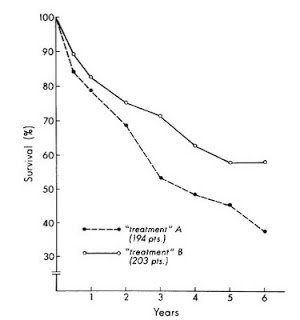The above figure compares long term survival in a subgroup of a trial that was published in Circulation in 1980. This was a randomized controlled trial of just over 1000 patients with known cardiovascular disease who were treated with medical therapy alone. The patients were randomized to two treatment groups and were followed for 5 years. In the primary analysis, there was no statistically significant difference in survival between the two groups. However, a subgroup analysis that compared only patients with 3-vessel disease and LV dysfunction at baseline (~200 patients in each group) found that the outcomes were significantly better in group B (p=0.025).
So
what was this treatment that was so successful in reducing mortality in group B?
There was no treatment. The patients were randomized to the two groups and then
simply followed with usual therapy. This study was designed to show the danger
of subgroup analyses and why they should be taken with a grain of salt. When
the authors looked deeper into the data, it became apparent that the patients
in group B were not as sick as those in group A and that the survival difference was
non-significant in a multivariable analysis. However, when they further
stratified the patients by only including those with no history of congestive
heart failure, the difference between the groups became more significant and
remained significant in the multivariable analysis (p=0.01).
what was this treatment that was so successful in reducing mortality in group B?
There was no treatment. The patients were randomized to the two groups and then
simply followed with usual therapy. This study was designed to show the danger
of subgroup analyses and why they should be taken with a grain of salt. When
the authors looked deeper into the data, it became apparent that the patients
in group B were not as sick as those in group A and that the survival difference was
non-significant in a multivariable analysis. However, when they further
stratified the patients by only including those with no history of congestive
heart failure, the difference between the groups became more significant and
remained significant in the multivariable analysis (p=0.01).
We
are often confronted by negative clinical trials in nephrology and other
disciplines and there is a natural tendency to try and find something useful
when these trials are completed. Like any multiple comparison, if you do enough
subgroup analyses, you will eventually find one that is significant. Any good statistician
will tell you that this needs to be accounted for in the final analysis but
this is not necessarily always done. Think about this trial when you are
reading about the wonderful effects of a treatment that was negative for most
but efficacious for a small group of patients with very specific attributes.
are often confronted by negative clinical trials in nephrology and other
disciplines and there is a natural tendency to try and find something useful
when these trials are completed. Like any multiple comparison, if you do enough
subgroup analyses, you will eventually find one that is significant. Any good statistician
will tell you that this needs to be accounted for in the final analysis but
this is not necessarily always done. Think about this trial when you are
reading about the wonderful effects of a treatment that was negative for most
but efficacious for a small group of patients with very specific attributes.


